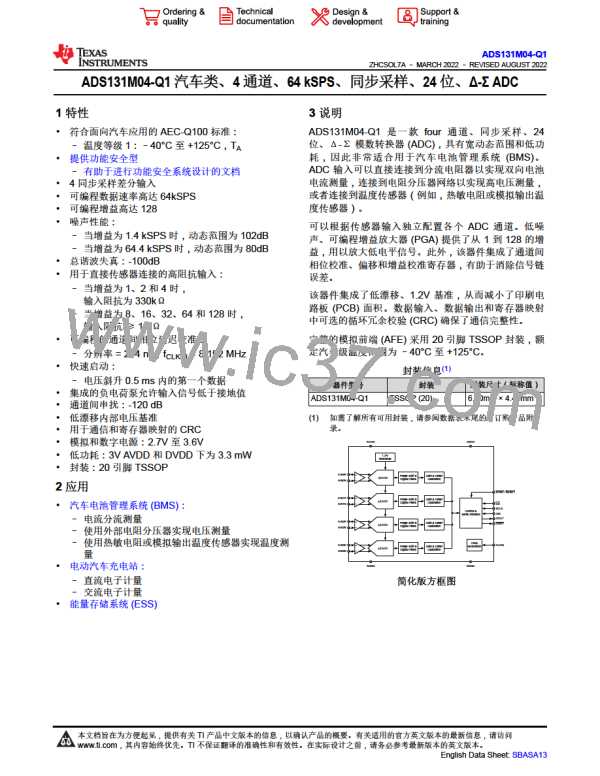ADS131M04-Q1
ZHCSOL7A –MARCH 2022 –REVISED AUGUST 2022
www.ti.com.cn
8.3.7.1.1 Fast-Settling Filter
At power-up or after a device reset, the ADS131M04-Q1 selects the fast-settling filter to allow for settled output
data generation with minimal latency. The fast-settling filter has the characteristic of a first-order sinc filter (sinc1).
After two conversions, the device switches to and remains in the sinc3 filter path until the next time the device is
reset or powered cycled.
The fast-settling filter exhibits wider bandwidth and less stop-band attenuation than the sinc3 filter. Consequently,
the noise performance when using the fast-settling filter is not as high as with the sinc3 filter. The first two
samples available from the ADS131M04-Q1 after a supply ramp or reset have the noise performance and
frequency response corresponding to the fast-settling filter as specified in the Electrical Characteristics table in
the Specifications section, whereas subsequent samples have the noise performance and frequency response
consistent with the sinc3 filter. See the Fast Start-Up Behavior section for more details regarding the fast start-up
capabilities of the ADS131M04-Q1.
8.3.7.1.2 SINC3 and SINC3 + SINC1 Filter
The ADS131M04-Q1 selects the sinc3 filter path two conversion after power-up or device reset. For OSR
settings of 64 to 1024 the sinc3 filter output directly feeds into the global-chop and calibration logic. For OSR
settings of 2048 and higher the sinc3 filter is followed by a sinc1 filter. As shown in 表8-3, the sinc3 filter operates
at a fixed OSR of 1024 in this case while the sinc1 filter implements the additional OSRs of 2 to 16. That means
when an OSR of 4096 (for example) is selected, the sinc3 filter operates at an OSR of 1024 and the sinc1 filter at
an OSR of 4.
The filter has infinite attenuation at integer multiples of the data rate except for integer multiples of fMOD. Like all
digital filters, the digital filter response of the ADS131M04-Q1 repeats at integer multiples of the modulator
frequency, fMOD. The data rate and filter notch frequencies scale with fMOD
.
When possible, plan frequencies for unrelated periodic processes in the application for integer multiples of the
data rate such that any parasitic effect they have on data acquisition is effectively canceled by the notches of the
digital filter. Avoid frequencies near integer multiples of fMOD whenever possible because tones in these bands
can alias to the band of interest.
The sinc3 and sinc3 + sinc1 filters for a given channel require time to settle after a channel is enabled, the
channel multiplexer or gain setting is changed, or a resynchronization event occurs. See the Synchronization
section for more details on resynchronization. 表 8-3 lists the settling times of the sinc3 and sinc3 + sinc1 filters
for each OSR setting. The ADS131M04-Q1 does not gate unsettled data. Therefore, the host must account for
the filter settling time and disregard unsettled data if any are read. The data at the next DRDY falling edge after
the filter settling time listed in 表8-3 has expired can be considered fully settled.
表8-3. Digital Filter Start-Up Times After Power-Up or Resynchronization
OSR (OVERALL)
OSR (SINC3)
OSR (SINC1)
SETTLING TIME (tCLKIN)
64
128
64
N/A
N/A
N/A
N/A
N/A
2
728
856
128
256
256
1112
1624
2648
4696
8792
16984
33368
512
512
1024
2048
4096
8192
16384
1024
1024
1024
1024
1024
4
8
16
Copyright © 2022 Texas Instruments Incorporated
Submit Document Feedback
23
Product Folder Links: ADS131M04-Q1

 TI [ TEXAS INSTRUMENTS ]
TI [ TEXAS INSTRUMENTS ]